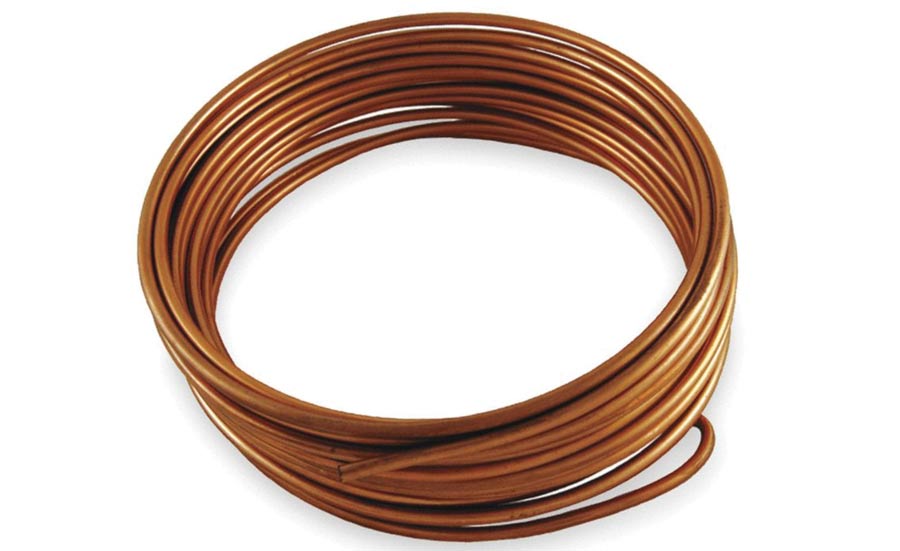As discussed in last month’s article, a capillary tube metering device is found mainly in domestic and small commercial applications and is nothing more than a long, fixed length tube with a very small diameter that is installed between the condenser and the evaporator. In this article, we will look take a closer look at capillary tube systems, as well as how to properly clean them.
OFF CYCLES
Capillary tube systems do not stop the flow of refrigerant after the compressor is shut off by the cycling control. In fact, refrigerant will continue to flow from the condenser to the evaporator until high and low pressures equalize. Most of the subcooled liquid in the condenser will flow through the capillary tube to the evaporator during the off-cycle, which is a main reason why the capillary tube system must be critically charged with refrigerant.
If there is too much liquid in the evaporator during the off-cycle, the compressor may be damaged during startups. The refrigerant charge should be able to satisfy the requirements of the evaporator and maintain a subcooled liquid seal at the condenser’s bottom and capillary tube’s entrance. If any excess refrigerant is added past the critical charge, subcooled liquid will back up in the condenser and cause high head pressures and unwanted efficiencies.
As mentioned in Part 1, the critical charge is usually stamped on the manufacturer’s data plate. It is important that larger commercial capillary tube systems have accumulators at their evaporator outlets to catch any liquid that may escape vaporization in the evaporator during start-ups. Liquid coming from the evaporator enters the bottom of the accumulator, and the vapors are drawn from the top into the compressor. Because of this pressure equalization during the off-cycles, capillary tube systems can employ motors with low starting torque. These motors usually use current or positive temperature coefficient resistor (PTCR) starting relays, sometimes without starting capacitors.
CLEANING CAPILLARY TUBES
One of the major problems with capillary tube systems is that they can become restricted or completely blocked due to foreign materials, freeze up (if water exists in the system), or kinks. Dirt, sandpaper grit, steel wool, refrigerant oil, and sand all can restrict or completely block capillary tubes. For this reason, it is extremely important to install a filter drier before the capillary tube in order to catch any foreign objects. Filter driers will also help catch moisture so it will not freeze at the evaporator entrance. Oil from a flooded compressor can also oil log a capillary tube and block its flow.
One symptom of a partially blocked capillary tube will be high head pressure from backed-up subcooled liquid in the condenser. This will starve the evaporator and cause low pressures in the low side of the system with very high evaporator superheats. The symptoms will vary in severity, depending on how badly the capillary tube is restricted. A completely plugged capillary tube system will have dangerously high head pressures along with evaporator pressures in the vacuum range.
If a system has a lot of moisture, this moisture will pass through the condenser and travel through the capillary tube. Once the moisture experiences the sudden pressure drop of the evaporator, it will gradually begin to freeze. This freezing around the inside diameter of the capillary tube will cause a slight restriction and hinder the system’s performance. Head pressures will elevate, and evaporator pressures will drop from the partial restriction. If the moisture problem is severe, this frozen layer will soon cause an entire restriction and shut down the compressor, usually by its thermal overload. Once the system is off, the frozen layers will melt and system pressures will equalize, waiting for the thermal overload to reset. The system will have to be dehydrated, evacuated, and recharged.
There are hydraulic capillary tube cleaners on the market that can be very successful in removing foreign objects from capillary tubes, if used properly. This technique, which involves applying hydraulic pressure to one end of the capillary tube, is usually done with the capillary tube removed from the system, or by removing one end from the system. Some capillary tubes may require a small piece of wire to be hydraulically blown through them in order to clean foreign objects and sludge from their internal diameter. One kit comes with coils of small wire pistons to clear capillary tubes, as well as a hydraulic cleaner, file, and capillary tube diameter gauge. The wire is just undersized enough to act as a piston to clear the capillary tube when used with the hydraulic cleaner.
Some technicians may simply replace the capillary tube with a new one if the original is plugged or restricted. In this case, the replacement capillary tube must have the same diameter, length, and number of coils or turns. There are capillary tube gauges on the market for measuring the right diameter of a capillary tube. When cutting a capillary tube, simply filing a small V-notch in the side of the capillary tube with an appropriate file and bending the tube back and forth where the V-notch is cut will make for a nice, clean break. Burrs at the end of capillary tubes will hinder refrigerant flow and cause inefficient system performance.
Soldering the capillary tube in place requires special skill. The capillary tube must be inserted about 1 to 2 inches past where the solder joint is to be made. This will ensure that solder will not creep up or down by capillary action and block the inlet or outlet of the capillary tube. A little bit of refrigeration oil smeared on the end of the capillary tube may help stop the solder from bonding to the capillary tube’s end. When crimping the line where the capillary tube is inserted, care must be taken not to crimp or harm the capillary tube itself.
See more articles from this issue here!



Report Abusive Comment